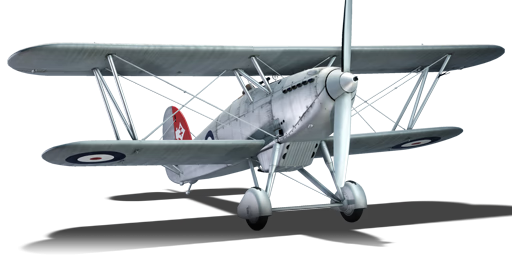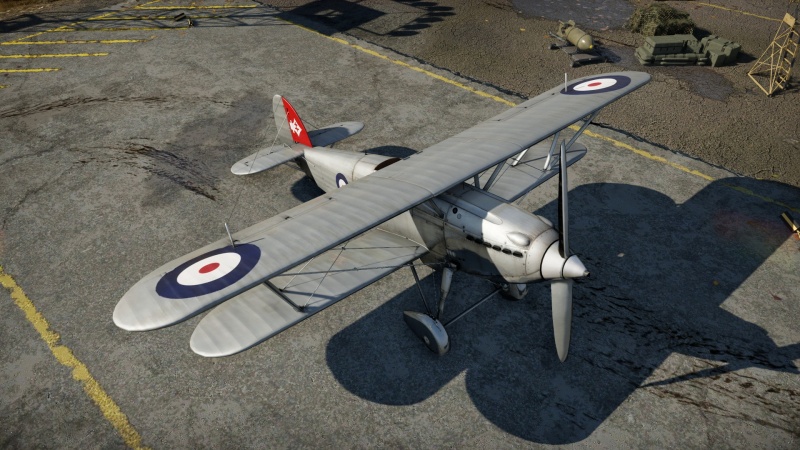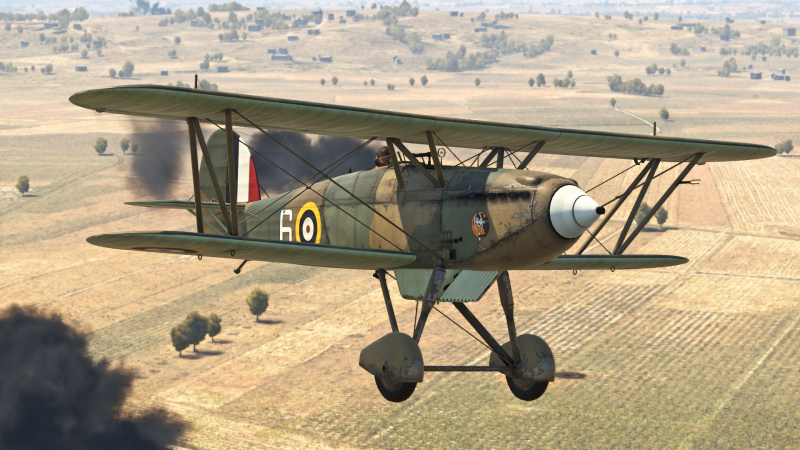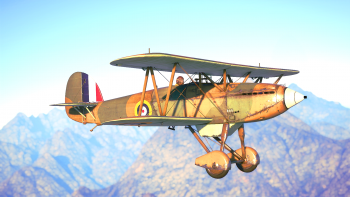Difference between revisions of "Fury Mk II"
m (Tag: Visual edit) |
Colok76286 (talk | contribs) (Edits) |
||
| Line 101: | Line 101: | ||
== Usage in battles == | == Usage in battles == | ||
<!-- ''Describe the tactics of playing in the aircraft, the features of using aircraft in a team and advice on tactics. Refrain from creating a "guide" - do not impose a single point of view, but instead, give the reader food for thought. Examine the most dangerous enemies and give recommendations on fighting them. If necessary, note the specifics of the game in different modes (AB, RB, SB).'' --> | <!-- ''Describe the tactics of playing in the aircraft, the features of using aircraft in a team and advice on tactics. Refrain from creating a "guide" - do not impose a single point of view, but instead, give the reader food for thought. Examine the most dangerous enemies and give recommendations on fighting them. If necessary, note the specifics of the game in different modes (AB, RB, SB).'' --> | ||
| − | The Fury Mk II is similar to the [[Fury Mk I|Mk I]] in terms of usage, although it is slightly faster, but not by much. It has good | + | The Fury Mk II is similar to the [[Fury Mk I|Mk I]] in terms of usage, although it is slightly faster, but not by much. It has good manoeuvrability to avoid being shot at, so turning is one of its strong points, but there are still some enemy planes that will be able to out turn it. Working with your team will greatly increase the chances for survival and to score a kill during engagement. |
Still lacking in firepower like its predecessor, the Mk I, the Mk II is not great at head on combat and will have greater chances engaging from the sides or above, though turning can work during some engagements. Certain enemies that can out turn the Fury you will struggle against, its better to try a new tactic like "boom and zoom" dive and use speed and energy advantages to make passes on the enemy aircraft. Most engagements will likely turn into a turn fight. | Still lacking in firepower like its predecessor, the Mk I, the Mk II is not great at head on combat and will have greater chances engaging from the sides or above, though turning can work during some engagements. Certain enemies that can out turn the Fury you will struggle against, its better to try a new tactic like "boom and zoom" dive and use speed and energy advantages to make passes on the enemy aircraft. Most engagements will likely turn into a turn fight. | ||
Revision as of 07:18, 2 June 2023
| This page is about the British fighter Fury Mk II. For the other version, see Fury Mk I. For other uses, see Fury (Disambiguation). |
Contents
Description
The Fury Mk II is a rank I British fighter with a battle rating of 1.0 (AB/RB/SB). It has been in the game since the start of the Open Beta Test prior to Update 1.27.
The Hawker Fury Mk II is a slightly improved version of the Mk I, this time featuring WEP. Both of them are reserve planes for the British tree. They also have the same armament, 2 x 0.303 in (7.7 mm) Vickers Mk IV machine guns. Unlike the other Hawker reserve planes, both Furies are land-based fighters.
General info
Flight performance
| Characteristics | Max Speed (km/h at 4,100 m) |
Max altitude (metres) |
Turn time (seconds) |
Rate of climb (metres/second) |
Take-off run (metres) | |||
|---|---|---|---|---|---|---|---|---|
| AB | RB | AB | RB | AB | RB | |||
| Stock | 381 | 367 | 8100 | 16.5 | 17.0 | 12.5 | 12.5 | 232 |
| Upgraded | 408 | 394 | 15.8 | 16.0 | 19.9 | 15.7 | ||
Details
| Features | ||||
|---|---|---|---|---|
| Combat flaps | Take-off flaps | Landing flaps | Air brakes | Arrestor gear |
| X | X | X | X | X |
| Limits | ||||||
|---|---|---|---|---|---|---|
| Wings (km/h) | Gear (km/h) | Flaps (km/h) | Max Static G | |||
| Combat | Take-off | Landing | + | - | ||
| 600 | 600 | N/A | N/A | N/A | ~11 | ~5 |
| Optimal velocities (km/h) | |||
|---|---|---|---|
| Ailerons | Rudder | Elevators | Radiator |
| < 260 | < 200 | < 300 | > 200 |
Survivability and armour
The Fury Mk II has no armour plating or bullet-proof glass. All modules are concentrated in the forwards fuselage.
- No armour protection
- Self-sealing fuel tanks
Modifications and economy
Armaments
Offensive armament
The Fury Mk II is armed with:
- 2 x 7.7 mm Vickers E machine guns, nose-mounted (600 rpg = 1,200 total)
Usage in battles
The Fury Mk II is similar to the Mk I in terms of usage, although it is slightly faster, but not by much. It has good manoeuvrability to avoid being shot at, so turning is one of its strong points, but there are still some enemy planes that will be able to out turn it. Working with your team will greatly increase the chances for survival and to score a kill during engagement.
Still lacking in firepower like its predecessor, the Mk I, the Mk II is not great at head on combat and will have greater chances engaging from the sides or above, though turning can work during some engagements. Certain enemies that can out turn the Fury you will struggle against, its better to try a new tactic like "boom and zoom" dive and use speed and energy advantages to make passes on the enemy aircraft. Most engagements will likely turn into a turn fight.
Most aircraft at 1.0 lack the armour protection to take great amount of damage, pilots are exposed so it's easier to pilot snipe or get pilot sniped by a bullet and get shot down easily. But it goes both ways for the Fury and other biplanes.
Specific enemies worth noting
Ki-10 - The Ki-10 is can easily out turn the Fury Mk II in a turning engagement. The best tactic to use against the Ki-10 is to dive on them and use boom and zoom tactics. Also, remember due to the weak engine of the Fury Mk II it is not easy to climb or maintain its energy.
I-15 - The I-15 is another opponent that the Fury Mk II will lose to in a turning engagement. When battling the I-15, the tactics of an aerial engagement against the Ki-10 maintains the same. Do not try to head on an I-15 at all costs as well, as its 4 machine guns will easily outmatch the two machine guns carried by the Fury Mk II.
He 100 D-1 - The He-100 D-1 is the fastest aircraft the Fury Mk II will face, most likely will boom and zoom and make a lot of passes. With a top speed of 693 km/h(AB)/ 670(RB) makes the He-100 D-1 one of the fastest aircraft the Fury Mk II will engage. It also got three MG 17 (7.92 mm) and will out gun the Fury's two Vickers E (7.7 mm) machine guns.
Manual Engine Control
| MEC elements | ||||||
|---|---|---|---|---|---|---|
| Mixer | Pitch | Radiator | Supercharger | Turbocharger | ||
| Oil | Water | Type | ||||
| Controllable | Not controllable Not auto controlled |
Not controllable Not auto controlled |
Controllable Not auto controlled |
Combined | Not controllable 1 gear |
Not controllable |
Pros and cons
Pros:
- Turns well for a biplane, especially in vertical manoeuvres
- Incredibly low stall speed
- Machine guns have a high rate of fire for a reserve aircraft
- Plenty of ammo
Cons:
- Sluggish acceleration and climb rate (equipped with fixed-pitch prop)
- Only has two rifle-calibre machine guns that do not usually do much damage to the target
- Loses energy quite easily, mostly able to turn just once or twice
- Not very beginner-friendly due to its flying characteristics
- Engine tends to overheat, especially so on hot maps (RB/SB)
- No armour, open cockpit
- Prone to wing breaking in a shallow dive (RB/SB)
History
The Hawker Fury (Mk I) entered service in 1931 and was the first RAF fighter to exceed 200 mph (320 km/h) in level flight. The Mark II was even faster and both types of Furies remained in service with various air forces right up to the start of WWII.
A special version fitted with a Bristol radial engine was built for Iran/Persia, but most 'normal' Furies had a Rolls-Royce Kestrel of 525 hp or 640 hp.
Many other versions of the Hawker Fury were made, including the Yugoslav, Persian, Norwegian, Portuguese and Spanish Furies.
The Fury was armed with 2 x 7.7 mm machine guns.
| Archive of the in-game description | |
|---|---|
|
Hawker Aircraft Ltd failed to receive an order for the Fury Mk.I in the amount they had expected, so work to improve the fighter continued in the hopes of expanding production. The company intended to install a new Rolls-Royce Goshawk engine on the aircraft; however, due to the engine's protracted fine-tuning phase, an improved 640 hp Rolls-Royce Kestrel VI twelve-cylinder engine was fitted on the aircraft instead. These new fighters equipped with this engine were designated Fury Mk.II. Externally, the Fury Mk.II differed from the previous variant mainly in its landing gear wheel fairings, which were more streamlined. Other external differences included additional stabilizer braces and a small air intake on the lower section of the forward fuselage. Fury Mk.IIs made towards the end of production had a wheel instead of a tail skid. The fuel tank's capacity was increased; however, the additional weight and different powerplant's consumption resulted in the Mk.II having a shorter range. The first production Fury Mk.II entered service with No. 25 Squadron in early 1937. A total of 98 Fury Mk.II aircraft were built in two series, after which Hawker Aircraft Ltd switched focus to the mass production of the Hurricane fighter. Fury fighters attracted the attention of foreign customers and were built to be exported to the Air Forces of Spain, Norway, Iran (Persia), Portugal, the Union of South Africa, and Yugoslavia. Furies took part in combat operations in the Spanish Civil War in 1937. In Great Britain, the aircraft was withdrawn from service with operational RAF squadrons in 1939, but remained in service with flying schools as a trainer until 1944. South African squadrons flew Furies against the Italians in East Africa in 1940; the small contingent of Furies in service with Yugoslavia fought the German invasion in April 1941 and were almost completely destroyed. In Iran, Fury fighters were in service until late 1942. Nearly 300 Hawker Furies of all variants were built. Whilst obsolete as a fighter by the outbreak of the Second World War, those Furies which did oppose modern aircraft were operated with great skill and bravery, scoring some successes despite their antiquity. Many design aspects of the Fury would help form the basis of the Hawker Hurricane. | |
Media
- Skins
See also
Links to the articles on the War Thunder Wiki that you think will be useful for the reader, for example:
- reference to the series of the aircraft;
- links to approximate analogues of other nations and research trees.
External links
Paste links to sources and external resources, such as:
- topic on the official game forum;
- other literature.
| Hawker Aircraft Limited | |
|---|---|
| Biplane fighters | |
| Fury | Fury Mk I · Fury Mk II |
| Nimrod | Nimrod Mk I · Nimrod Mk II |
| Scout plane | Osprey Mk IV |
| Piston fighters | |
| Hurricane | Hurricane Mk I/L · Hurricane Mk.I/L FAA M · Sea Hurricane Mk IB · Sea Hurricane Mk IC · Hurricane Mk IIB/Trop · Hurricane Mk IV |
| Typhoon | Typhoon Mk Ia · Typhoon Mk Ib · Typhoon Mk Ib/L |
| Tempest | Tempest Mk V · Tempest Mk V (Vickers P) · Tempest Mk II |
| Fury | Sea Fury FB 11 |
| Jet fighters | |
| Hunter | Hunter F.1 · Hunter F.6 · Hunter FGA.9 |
| Sea Hawk | Sea Hawk FGA.6 |
| Harrier | Harrier GR.1 · Harrier GR.3 |
| Export | ▄Hurricane Mk I/L · ▂Hurricane Mk IIB · ◘Sea Fury FB 51 |
| ◘Sea Hawk Mk.50 · ◄Sea Hawk Mk.100 · ◘Hunter F.6 · ◌Hunter F.58 · J34 · AV-8A · AV-8C · ▄AV-8S | |
| Captured | ▀Tempest Mk V |
| See Also | Fokker |







